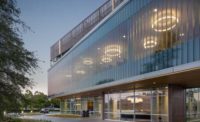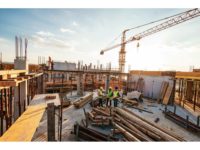The resilient performance and natural beauty of zinc has been demonstrated for more than 200 years on European roofs. In recent decades, the enduring qualities of zinc have gained interest and use in North America. Increasingly, zinc roofing products are recognized for their dynamic appearance and design flexibility, resilient performance, cost-effective fabrication and installation, low-maintenance, sustainability and longevity with a potential lifespan of 80 years or more.
Dynamic Appearance
A time-proven, dependable material, zinc roofing products complement both contemporary and traditional architectural styles, and foster a connection to their surrounding natural environment.
Mill-finish zinc starts with a bright, light-reflective surface similar to mill finish aluminum. Most architects, however, select zinc for its future patina appearance. Like copper, zinc develops its distinctive patina based on the alloy composition and local environmental conditions.
A patina’s formation is a process of the gradual growing together of zinc carbonate “freckles.” The rate of the patina’s formation is related to the slope of the surface. The patina will form slower on a vertical wall surface than on a slightly pitched roof. The patination speed varies between six months and five years or more, depending on climatic conditions. The more exposure to wetting and drying cycles, the quicker the patina will develop.
After the true patina has fully formed the process will slow down but never stops. Ultimately, the natural patina will form to a soft blue-gray or graphite-gray color, depending on the alloy. The patina in marine environments is usually lighter in color because of chlorides found in the atmosphere.
In North America, ASTM B69-16, Standards Specification for Rolled Zinc, is the primary reference document for both Architectural Rolled Zinc Type 1 and Type 2 alloys and their expected characteristics. Architectural Rolled zinc is efficiently produced by alloying Special High-Grade, 99.995 percent pure zinc with very small quantities of copper, titanium and aluminum. The zinc alloy composition determines whether the metal will tend toward a blue-gray or graphite-gray coloration.
To accelerate the patina’s formation and distinctive look, at least one manufacturer offers a pre-weathered zinc material. Alternatively, factory-finished options also are available to achieve an initial, uniform aesthetic. Three common methods to adjust the zinc’s color prior to installation are:
- Pickling is a pre-treatment process that chemically etches the metal and derives the colorfrom the alloy. The resulting appearance brings out the metal’s natural gray color and subtle grain texture, and will naturally patinate as it ages.
- Phosphating is a treatment where phosphate crystals are deposited on the surface to create a darker color from the titanium or copper alloy. The resulting color is produced by the coating.
- Color coating is applied to the zinc and seals the metal with a selected color during its manufacturing process. The resulting color is imparted by the coating and no patina will form.
Design Flexibility
A soft, lightweight metal, zinc adapts to complex roofing geometries and can be fabricated to fit almost any slope, curve or linear run. It also can be perforated and fashioned into ornamental accents.
Zinc roofing products can be installed on low sloped, steep sloped, flat and mansard roofs, and used for hip and ridge caps, drip edges, valleys, step flashing, dormers, cupolas, parapets and more. Mechanically locked, standing-seam roof panel profiles are the most common for zinc roofs.
Consult the roofing panel system’s manufacturer for minimum pitch requirements and custom seam profiles. For example:
- Flat seam profiles rely on gravity and at least a 4:12 slope to maintain weathertightness.
- Low-profile zinc shingles and interlocking or overlapping tiles applied parallel to the eave present another familiar aesthetic. They involve a technically easier installation method than vertical joints and always are applied as a “dry-joint” roof system without solder or sealant. Tiles can be small. They provide good wind resistance, but cannot provide the same level of weather protection as a vertical seam.
- For vertical seam profiles, vertical joints are attached to one vertical side joint, overlapped and closed on the opposite side. The soft metal simplifies the task of hand-seaming or power-seaming zinc panels. Long panel lengths can make this design more vulnerable to oil-canning (panel waviness), panel disengagement and wind uplift. Accommodating longer panels, taller seams and those with added capillary breaks offer better water and wind resistance, critical in many coastal applications.
- Double-lock and single-lock seam joints between roof panels stand 1-inch or 1.5 inches up from the draining plane. A raised seam height can emphasize the roof as a design element and have a functional purpose in coastal climates with snow.
Resilient and Cost-Effective
Zinc’s performance has been successfully tested both in laboratories and proven for generations of use in the field. A roofing system should comply with the project’s local building code requirements.
Installed properly, zinc roofing systems will resist corrosion, air and water infiltration. For regions with high winds and hurricane conditions, zinc roofing systems have been tested to withstand winds reaching up to 150 mph. In environments that are susceptible to fires, zinc also provides a noncombustible solution.
All roof surfaces should have positive drainage. Zinc roofs should have a structured underlay. This creates an air space that facilitates the movement of moisture to flow away or evaporate. Self-adhered, high-temperature roof underlayments are recommended. Synthetic felts may be utilized on steep pitch roofs in combination with self-adhered high-temperature underlayments at vulnerable roof conditions and roof penetrations.
Benefiting all involved on the project, most architectural zinc manufacturers offer in-depth information on efficient and cost-effective fabrication and installation. As examples:
- When detailing a zinc system, it should be noted that some details require less labor. Since labor represents 66 percent or more of the contract, expensive time-consuming details should be reviewed to ensure they are necessary to fulfill the architect’s vision.
- Panel sizes should be chosen to optimize the full width of the zinc sheet or coil and to minimize scrap material. Similarly, panel lengths should be limited for easier handling, fabricating and installing, as well as to reduce waste in the shop and the field.
- Fewer pieces can save time and labor. However, heavier gauge zinc or smaller panels may be necessary to reduce perceived waviness (oil-canning).
- Roll-forming zinc panels are almost always less expensive than folding. Corrugated, standing seam and batten seam panels are all systems that can be roll-formed. If the material temperature is below 50 degrees Fahrenheit, zinc becomes brittle; the risk of fracture while folding increases as the temperature decreases.
- Zinc has a high coefficient of thermal expansion and should have accommodations in the design to allow for movement. Caulking often is not required at these critical junctures, helping to lower initial and lifetime costs, and to reduce recurring maintenance.
- Use sealants that are PH-neutral. Avoid placing zinc in contact with or downstream from acidic materials, including woods such as oak, red cedar, white cedar, larch, hemlock or chestnut. Red rosin paper also produces an acidic vapor and should never be used as a slip sheet.
- The first consideration at any joint should be how to achieve the detail without solder or sealant. Sealants can limit airflow or trap moisture behind the zinc panels and decrease the panel’s lifespan. Beware that soldering at a high heat can burn through zinc. If soldering is essential, choose one that does not contain lead, cadmium or copper to maintain zinc’s environmental material attributes.
Designating one zinc manufacturer as the basis of design will further minimize opportunities variations in material performance. Selecting a zinc manufacturer that certifies its material to Architectural Rolled Zinc ASTM B69-16, and has demonstrated its experience in similar climates and applications, offers a good indication that they will prove successful on future projects. A mock-up also can be requested to ensure the specified zinc roofing system meets the project’s aesthetic, performance and installation requirements,.
Low Maintenance
Zinc’s inherent metallic properties allow the material to deliver low-maintenance and long-lasting performance in roofing applications. During their many years of use, zinc roofs do not rot or rust. No paint, varnish or sealants are required, and its run-off is non-staining.
Some metals will corrode if not properly protected from salt in the atmosphere. White deposits from salt in the atmosphere can develop on all metal roofing materials. Lighter colored coatings and substrates, including natural metals such as zinc, show salt less.
Many regions receive enough rainfall to sufficiently and naturally rinse salt and particulates off the metal roofing. For aesthetic reasons, it is recommended to clean the surface of the material with clean water (not seawater) at least twice a year or more, if necessary, in maritime climate zones, depending on local conditions.
Follow the manufacturer’s cleaning instructions. Some manufacturers may require washing for their warranty. Many manufacturers have exclusions in “splash zones.”
If zinc is scratched, scuffed or fingerprinted, the metal will heal itself by re-patinating. With time and exposure to wetting and drying cycles, the former blemish will patinate and blend to match.
Sustainability and Longevity
Beyond a roof’s weather-protective and pest-resistant function, zinc roofs also can support energy-efficient, energy-producing and water-harvesting goals. If rooftop photovoltaic array is planned, non-penetrating clamps can be used on standing-seam profiles to attach the solar panels to the roof. Zinc roofing accessories also can be added to collect and divert rainwater, such as for naturally irrigated landscaping.
Zinc is an abundant natural resource. Based on known ore reserves, the world’s zinc supply is estimated in excess of 200 million tons and expected to last approximately 700 years. Thoughtful manufacturers increase zinc’s efficient, environmental production by immediately returning any scrap to the production stream, utilizing state-of-the-art equipment to minimize emissions, and incorporating both pre- and post-consumer recycled content in the resulting material.
Zinc requires 25-33 percent less energy to produce than metals such as aluminum, copper and stainless steel. Using recycled zinc material requires 5 percent less energy than smelting raw material. Zinc remains 100 percent recyclable after a potential lifespan of 80 years or more on a building’s roof.
The sustainable benefits of architectural zinc products support criteria for several green building programs including BREEAM certification, the Green Globes system, the U.S. Green Building Council’s LEED rating system, and the Cradle to Cradle Products Innovation Institute.
Products that have earned Cradle to Cradle certification demonstrate their product’s material does not release any toxic substances during usage, deconstruction and recycling; that it retains its original properties without loss of performance; and that can be re-used as a new item of at least equal value. This is known as upcycling; whereas downcycling results in recycling material to become inferior products, and non-recyclable products will be sent to a landfill.
Collaboration between architects, specifiers, contractors, manufacturers, fabricators and installers will help ensure a roof that provides long-lasting functionality and appearance, achieving the best results for the building owner.






